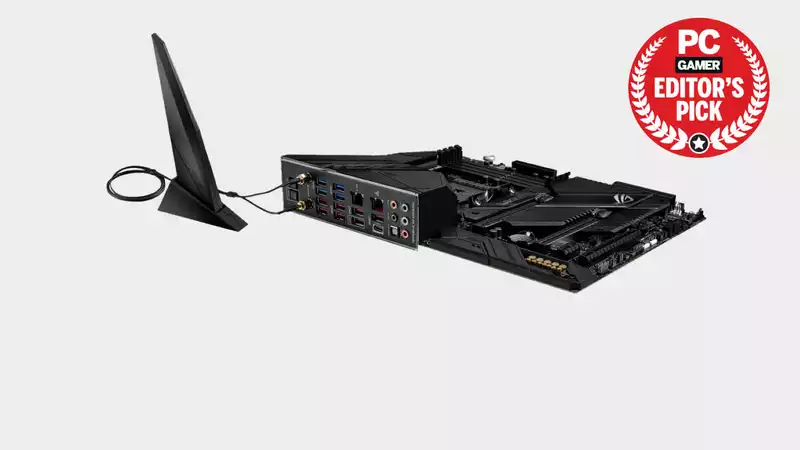No new chipset will debut with the AMD Ryzen 5000 CPU, but Asus' ROG Crosshair VIII Dark Hero is hoping to be the last AM4 motherboard you need.
AMD's AM4 socket, which debuted in September 2016, is now in the twilight of its long career, and since the X670 chipset is not likely to appear, the X570 is the last before switching to a new socket for Zen 4 processors with DDR5 memory support It is likely to be the high-end AM4 chipset.
With this in mind, Asus is using this window to release a refreshed X570 motherboard, the ROG Crosshair VIII Dark Hero. This motherboard incorporates over four years of BIOS updates, PCB, and electrical layout tweaks all into a mature and refined package. Importantly, unlike earlier X570 boards, Dark Hero is designed with the Zen 3 processor that was actually on hand during the design phase.
This means that the Crosshair VIII Dark Hero could very well be the best, if not the best, X570 motherboard for Ryzen 5000 CPUs.
The Dark Hero features a rather subtle design. Some might even call it a bit tasteless. Perhaps the "peak of RGB" has been reached, as modern motherboards implement RGB a bit more inconspicuously. It is also unusual to see no Crosshair VIII Apex or Extreme, especially when Gigabyte and MSI are offering boards priced far above Dark Hero. [but it certainly seems affordable compared to the exorbitant prices of the MSI Godlike and Gigabyte Aorus Extreme.
The layout of modern ATX boards tends not to change much. The primary M.2 slot is located above the PCIe slot. The second slot at the bottom is also equipped with a heatsink. The socket is easily accessible without having to remove the entire heatsink.
Also of note, there is no chipset cooling fan. Hooray. [Wired networking is provided by an Intel I211AT 1G and a Realtek RTL8125 2.5G controller; 5G would have been fine, but after nearly 20 years of putting up with gigabit, 2.5G is still welcome. Intel 802.11ax WiFi is also included, so networking options are plentiful.
The VRM is an upgrade over the regular Hero. The power stage is now rated at 90A instead of 60A, putting it on par with other premium X570 boards, and even if you're into beating benchmarks on LN2 (which you'll see a lot of in the hands of overclockers), this board is easy punishment will be able to do the same. The heatsinks are large and chunky.
The IO on the back is tightly packed. If you need additional USB ports for a head massager or plasma ball, few boards are better equipped than this one: there are eight USB 3.2 Gen 2 ports, one of which is Type-C. There are also eight USB 3.2 Gen 2 ports, one of which is Type-C. In addition to these, there are four USB 3.2 Gen 1 ports, a BIOS clear and flashback button, LAN and WiFi antenna ports, and the usual audio ports including S/PDIF. IO Shield comes preinstalled, standard on any decent motherboard. It is a standard feature.
Usually, performance differences between boards combining the same components are very small. In particular, BIOS glitches in the X570 chipset are now fully reconciled after several generations. In many cases, the variations are simply within the margin of error.
The AMD Ryzen 9 5950X used in our tests is highly dependent on cooling. Once that is resolved, however, it is clear that the combination of a Ryzen 9 5950X and a high-quality board like the Dark Hero can really shine, with or without overclocking. However, it must be stated that if you are a pure gamer, the AMD Ryzen 7 5800X or AMD Ryzen 5 5600X chips are better options.
The 5950X sample was easily benchmarked at 4.5 GHz. 5 GHz with all cores loaded, but above that, the CPU cooling must be of the highest specification.
An easier method than manual overclocking is to enable AMD Precision Boost Overdrive (PBO). With it enabled, our sample recorded 4.5 GHz on all cores, but more commonly settled at 4.4 GHz. The key is to leave the light-threaded boost enabled, as you can see in the benchmarks, under single-threaded and gaming loads, you get a big multi-threaded boost and lose nothing.
Also, the Infinity Fabric clock can reach 2,066 MHz, and combined with the 1:1 memory clock, DDR4-4133 at tight timing. This has never been achieved on any other Ryzen 5000 silicon or any other board; Dark Hero was capable of booting at even higher SoC and CCD voltages than this.
This is worth repeating: the latest AGESA update may improve the Infinity Fabric clock on other boards, but at the time of this writing no other motherboard has achieved this. It's always nice to get this kind of feeling from a robust motherboard: ah. It works surprisingly well.
So what makes a great motherboard? While features are important - a stable and polished BIOS, value for money, good design - sometimes it's the intangibles that matter. Sometimes it is whether the motherboard just works. Testing motherboards is one of the most painstaking things a technical journalist has to do. However, Dark Hero appeared to be the first to boot, even after playing around with memory clocks, timings, and Infinity Fabric.
The Crosshair VIII Dark Hero may not be the best AM4 motherboard ever made. We would need to review hundreds of boards to make that claim, but there is no doubt that the Dark Hero is one of the best AM4 motherboards we have ever tested. whether or not the Dark Hero will become one of the truly legendary ROG motherboards will depend on time and months of The only thing that will determine if Dark Hero will be one of the truly legendary ROG motherboards will be the feedback from users over the next few months.
.

Comments